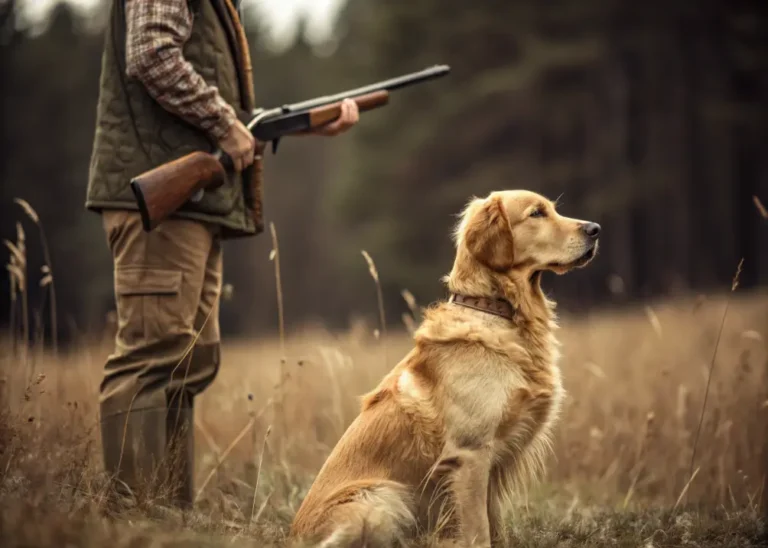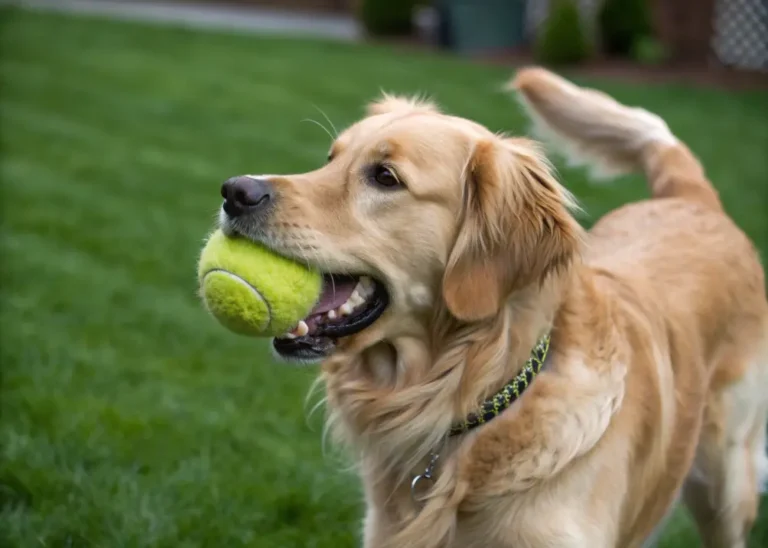From Pulling to Polite: Leash Training Your Golden Retriever
Golden Retrievers are like that overly excited friend who can’t wait to drag you into the fun — literally. If you’ve ever clipped on a leash and tried to take your Golden for a “peaceful” walk, chances are you’ve found yourself flying down the street behind 70 pounds of golden fluff with zero chill.
Don’t worry, you’re not alone. Leash pulling is one of the most common challenges Golden owners face. The good news? With patience, training, and a few clever techniques, your bouncy Golden can go from a tugboat to a polite walking partner. This blog will break it all down for you — step by step — with examples, stories, and a few “been there, survived that” moments all dog parents can relate to.

1. Why Do Golden Retrievers Pull on the Leash?
Before you can solve a problem, you’ve got to understand it. Goldens don’t pull because they’re “bad dogs.” They pull because:
- Excitement overload: They love the outdoors. New smells, people, dogs, squirrels… it’s like Disneyland for them.
- Natural strength: Goldens are strong, athletic dogs. Once they lean into the leash, physics takes over.
- Reinforcement: If pulling gets them where they want (park, tree, another dog), the behavior gets rewarded.
A lot of owners give up and think, “Well, that’s just how Goldens are.” But that’s not true. With proper leash manners, Goldens can walk calmly — and still enjoy all the sniffing and exploring they love.
Example: My neighbor’s Golden, Daisy, used to drag her owner across the street to greet every dog. After three months of consistent training, Daisy now walks calmly beside her. She still wiggles with joy when she sees another pup, but she waits until her leash is loose to say hello.

2. Getting the Right Tools for Training
You can’t build a house without tools, and you can’t leash-train without the right gear.
- Flat collar: Fine for identification and casual wear, but not always best for training pullers.
- No-pull harness: Many trainers recommend a front-clip harness because it redirects pulling without choking.
- Head halter: Like a horse halter, it gives you control over the dog’s head. Takes time for the dog to adjust.
- Leash: Stick with a standard 4–6 ft leash. Retractable leashes teach pulling and make training harder.
Personal note: I once tried walking a young Golden on a retractable leash. Big mistake. He spotted a squirrel, bolted, and the plastic handle flew out of my hand. Let’s just say I learned that day — never again.

3. Start with Indoor Practice
If your Golden is already a strong puller, don’t start on a busy street. Begin indoors or in your backyard, where distractions are minimal.
Steps:
- Clip on the leash.
- Hold a few small treats in your pocket or pouch.
- Walk a few steps. If the leash stays loose, reward your Golden.
- If they pull, stop walking. Wait until they return to you or loosen the leash, then continue.
This teaches them: pulling = no progress, staying close = walk continues and you get snacks.
It might feel slow, but trust me — it pays off outside.

4. The “Stop-and-Go” Technique
This is the simplest but most effective method. Every time your Golden pulls — you stop. No forward movement until the leash is loose again.
It’s boring, yes. You might feel like a tree. But dogs learn quickly that pulling makes the walk stop, while walking nicely gets them where they want to go.
Example: My friend tried this with her 2-year-old Golden, Max. The first few walks took forever, because she stopped every two steps. But within two weeks, Max figured it out: walking calmly = progress. Now her walks are a breeze.

5. The “Change of Direction” Game
If stopping feels too boring, make it a game. When your Golden pulls, simply turn around and walk the other way. Praise and treat when they follow.
It teaches your dog to pay attention to you instead of dragging you toward the next smell.
This also makes you the “leader of the adventure.” Instead of them choosing the route, they learn to check in with you.

6. Using Treats and Rewards the Right Way
Goldens are food-motivated (that’s a polite way of saying they’ll do anything for snacks). Use this to your advantage.
- Carry pea-sized treats (not big cookies).
- Reward frequently at first, then slowly reduce.
- Mix in verbal praise and petting — not just food.
One mistake people make: only treating at the end of the walk. Instead, reward small wins along the way.
Relatable note: Once, I forgot treats during a training walk. My Golden looked at me like, “Really? You expect me to behave with nothing in it for me?” Lesson learned — never leave without snacks.

7. Dealing with Distractions
Distractions are the ultimate test. Another dog, a jogger, or even a blowing leaf can send your Golden into pulling mode.
Tips:
- Practice in low-distraction areas first.
- Gradually work up to busier spots.
- Use the “watch me” cue (hold a treat near your face, reward eye contact).
- Teach “sit” as a default when excited.
It’s like building muscle — you start light and work heavier. Don’t take your Golden straight from the living room to a crowded festival.

8. Exercise Off the Leash Too
Here’s a secret: many Goldens pull simply because they’re bursting with energy. They’re an active breed (originally bred as hunting dogs), and without enough exercise, leash training becomes way harder.
- Give them daily off-leash time in safe areas.
- Play fetch in your yard.
- Try swimming (Goldens usually love it).
A tired Golden is a better-behaved Golden.

9. Common Mistakes to Avoid
- Yanking the leash: This can hurt their neck and doesn’t actually teach manners.
- Using retractable leashes: Encourages pulling since the leash is always tight.
- Being inconsistent: If sometimes you let them pull (“just this once”), they’ll never learn.
- Skipping training days: Consistency is key — even short daily sessions matter.

10. Real-Life Success Stories
- Bella’s transformation: Bella used to drag her owner across the park to chase ducks. After 6 months of steady training, she now walks calmly, only stopping to politely watch ducks from afar.
- Charlie’s confidence: A rescue Golden named Charlie was so reactive on leash he’d lunge at every dog. With patient work using stop-and-go and reward-based training, he’s now able to walk past other dogs with only mild curiosity.
- Everyday wins: Even teaching your Golden to pause at crosswalks instead of lunging forward can feel like a huge victory.

FAQs About Leash Training Golden Retrievers
How long does it take to leash train a Golden?
It depends — some learn in weeks, others take months. Consistency is the biggest factor.
What age should I start leash training?
Start as early as 8 weeks. Puppies can learn the basics quickly with short, positive sessions.
Can older Goldens learn leash manners?
Absolutely. It might take longer, but with patience, even seniors can improve.
Do no-pull harnesses really work?
Yes, many owners see immediate improvement, but you should still train — harnesses are a tool, not a fix.
What if my Golden pulls toward other dogs?
Practice focus exercises, increase distance at first, and reward calm behavior.
Is it cruel to use a head halter?
Not if introduced gently. Many trainers use them safely. Dogs may need time to adjust.
How long should daily training sessions be?
Short and sweet — 10–15 minutes of focused training, plus normal walks.
Why does my Golden behave in the yard but pull on the street?
The street has more distractions. Build up slowly from calm spaces to busy ones.
What if my Golden refuses to walk at all?
Sometimes it’s fear, pain, or confusion. Rule out medical issues with your vet, then try positive motivation.
Can leash training strengthen my bond with my Golden?
Yes! Walks become teamwork instead of a battle, which deepens trust and connection.

Conclusion: From Chaos to Calm
Walking your Golden Retriever doesn’t have to feel like a workout class you never signed up for. With the right tools, patience, and consistent practice, you can turn those tug-of-war walks into relaxing strolls. Remember, Goldens thrive on connection — they don’t just want to pull ahead, they want to be with you.
So grab some treats, take a deep breath, and turn your daily walk into a bonding adventure. With time, your Golden will go from pulling like a sled dog to walking politely like the loyal companion they were born to be.

References
- American Kennel Club (AKC) – Golden Retriever Breed Information
- Association of Professional Dog Trainers – Loose Leash Walking
- PetMD – How to Train Your Dog to Walk on a Leash
- Humane Society – Tips for Walking Dogs
we have many helpful blog post about Golden Retriever, you might want to check them out.
Health Problems in Golden Retrievers You Need to Know About
How Long Do Golden Retrievers Really Live?
Golden Retrievers as Therapy Dogs: Healing with Four Paws






